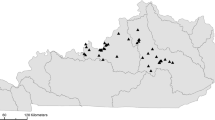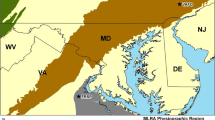Abstract
Rapid assessment methods (RAMs) have become an integral part of state and federal wetland programs by providing a consistent method for monitoring and prioritizing wetland conservation efforts. RAMs evaluate condition along an anthropogenic disturbance gradient based on qualitative and quantitative measures of wetland indicators. However, RAM applicability outside of the intended region may be difficult or inappropriate due to differences in wetland types, natural variability, and types of stressors. Given the influence of regional and wetland variability on the effectiveness of RAMs, our approach focused on the development and validation of a method applicable to specific wetland types found in Oklahoma and other regions in the Central Great Plains. We applied the Oklahoma Rapid Assessment Method (OKRAM) in 28 depressional wetlands across the state and evaluated the method’s ability to detect condition along a disturbance gradient. We found consistent relationships between OKRAM scores and plant data (e.g., Floristic Quality Index, species richness, and diversity) and with a landscape assessment of anthropogenic disturbance. Based on our results, OKRAM has utility as a tool for differentiating between high and low quality depressional wetlands in Oklahoma, with potential for applicability across other regions of the Central Great Plains.



Similar content being viewed by others
References
Adamus P, Verble K, Rudenko M (2016) Manual for the Oregon rapid wetland assessment protocol (ORWAP, revised) version 3.1. Oregon Department of State Lands, Salem
Albanese G, Davis CA (2015) Characteristics within and around stopover wetlands used by migratory shorebirds: is the neighborhood important? Condor 117:328–340
Andreas BK, Lichvar RW (1995) Floristic index for establishing assessment standards: A case study for northern Ohio. Technical Report WRP-DE-8. U.S. Army Corps of Engineers, Waterways Experiment Station, Vicksburg
Andreas BK, Mack JJ, McCormac JS (2004) Floristic quality assessment index (FQAI) for vascular plants and mosses for the state of Ohio. Ohio Environmental Protection Agency, Division of Surface Water, Wetland Ecology Group, Columbus
Apfelbeck R, Farris E (2005) Montana wetland rapid assessment method guidebook, version 2. Montana Department of Environmental Quality Planning, Prevention and Assistance Division Water Quality Planning Bureau Wetland Section, Helena
Bried JT, Jog SK, Dzialowski AR, Davis CA (2014) Potential vegetation criteria for identifying reference-quality wetlands in the South-Central United States. Wetlands 34:1159–1169
Brinson MM (1993) A hydrogeomorphic classification for wetlands. Technical Report WRP-DE-4. U.S. Army Corps of Engineers, Waterways Experiment Station, Vicksburg
Brown MT, Vivas MB (2005) A landscape development intensity index. Environmental Monitoring and Assessment 101:289–309
Chamberlain SJ, Brooks RP (2016) Testing a rapid floristic quality index on headwater wetlands in Central Pennsylvania, USA. Ecological Indicators 60:1142–1149
Chipps SR, Hubbard DE, Werlin KB, Haugerud NJ, Powell KA, Thompson J, Johnson T (2006) Association between wetland disturbance and biological attributes in floodplain wetlands. Wetlands 26:497–508
Collins JN, Stein ED, Sutula M, Clark R, Fetscher AE, Grenier L, Grosso C, Wiskind A (2013) California rapid assessment method (CRAM) for wetlands. Depressional Wetlands Field Book version 6.1, San Francisco Estuary Institute, Oakland
Crawley MJ (2013) The R book, 2nd edn. Wiley, Chichester
DeKeyser ES, Biondini M, Kirby D, Hargiss C (2009) Low prairie plant communities of wetlands as a function of disturbance: physical parameters. Ecological Indicators 9:296–306
Dvorett D, Bidwell J, Davis C, DuBois C (2012) Developing a hydrogeomorphic wetland inventory: reclassifying national wetlands inventory polygons in geographic information systems. Wetlands 32:83–93
Dvorett D, Bidwell J, Davis C, Dubois C (2013) Assessing natural and anthropogenic variability in wetland structure for two hydrogeomorphic riverine wetland subclasses. Environmental Management 52:1009–1022
Dvorett D, Davis C, Sherrod E, Koenig P, Tramell B (2014) Oklahoma rapid wetland condition assessment method (OKRAM) development: initial validation of draft OKRAM on interdunal wetlands. Wetland program development project. Oklahoma State University, Oklahoma Water Resources Board, Oklahoma Conservation Commission, Stillwater
Dvorett D, Davis C, Papes M (2016) Mapping and hydrologic attribution of temporary wetlands using recurrent landsat imagery. Wetlands 36:431–443
Euliss NH, Mushet DM (2011) A multi-year comparison of IPCI scores for prairie pothole wetlands: implications of temporal and spatial variation. Wetlands 31:713–723
Fennessy MS, Geho R, Elfritz B, Lopez R (1998) Testing the floristic quality assessment index as an indicator of riparian wetland disturbance. Ohio Environmental Protection Agency, Wetlands Unit, Division of Surface Water, Columbus
Fennessy MS, Jacobs AD, Kentula ME (2007) An evaluation of rapid methods for assessing the ecological condition of wetlands. Wetlands 27:543–560
Gallaway S, Davis C, Dvorett D, Tramell B (2016) Development and validation of a rapid assessment method for determining condition of Oklahoma wetlands. Wetland program development project. Oklahoma State University, Oklahoma Conservation Commission, Stillwater
Gallaway S (2017) Evaluating the effectiveness of wetland assessment methods for determining the condition of depressional and lacustrine fringe wetlands in Oklahoma. Master’s Thesis. Oklahoma State University, Stillwater
Gallaway S, Davis C, Dvorett D, Tramell B (2019) Evaluating the effectiveness of floristic quality assessment as a tool for determining the condition of depressional wetlands across ecoregions. Ecological Indicators 102:488–496
Garrison BY (2013) Validation of Kentucky wetlands rapid assessment method (KY-WRAM) metrics using macroinvertebrate communities of forested depressional wetlands. Dissertation, Eastern Kentucky University, Richmond
Gibbons JW (2003) Terrestrial habitat: a vital component for herpetofauna of isolated wetlands. Wetlands 23:630–635
Hoagland B (2000) The vegetation of Oklahoma: A classification for landscape mapping and conservation planning. The Southwestern Naturalist 45:385–420.
Jacobs AD (2010) Delaware rapid assessment procedure version 6.0. Delaware Department of Natural Resources and Environmental Control, Dover
Johnson B, Beardsley M, Doran J (2013) Functional assessment of Colorado wetlands (FACWet) method, version 3.0. Colorado Dept. of Transportation, Environmental Programs Branch, Denver
Kutcher TE (2011) Rhode Island rapid assessment method user's guide: RIRAM version 2.1. Rhode Island Department of Environmental Management, Kingston
Lopez RD, Fennessy MS (2002) Testing the floristic quality assessment index as an indicator of wetland condition. Ecological Applications 12:487–497
Mack JJ (2001) Ohio rapid assessment method for wetlands, manual for using version 5.0. Ohio EPA Technical Bulletin Wetland/2001-1-1. Ohio Environmental Protection Agency, Division of Surface Water, Columbus
Mack JJ (2006) Landscape as a predictor of wetland condition: an evaluation of the landscape development index (LDI) with a large reference wetland dataset from Ohio. Environmental Monitoring and Assessment 120:221–241
Mack JJ, Micacchion M, Augusta LD, Sablack GR (2000) Vegetation indices of biotic integrity (VIBI) for wetlands and calibration of the Ohio rapid assessment method feor wetlands v. 5.0. Ohio Environmental Protection Agency, Division of Surface Water, Columbus
Margriter SC, Bruland GL, Kudray GM, Lepczyk CA (2014) Using indicators of land-use development intensity to assess the condition of coastal wetlands in Hawai‘i. Landscape Ecology 29:517–528
Matthews JW (2003) Assessment of the floristic quality index for use in Illinois, USA wetlands. Natural Areas Journal 23:53–60
Micacchion M (2004) Integrated wetland assessment program part 7: Amphibian index of biotic integrity (AmphIBI) for Ohio wetlands. Technical Report WET/2004–7. Ohio Environmental Protection Agency Division of Surface Water, Columbus
Miller SJ, Wardrop DH (2006) Adapting the floristic quality assessment index to indicate anthropogenic disturbance in Central Pennsylvania wetlands. Ecological Indicators 6:290–312
Mohlenbrock RH (2005) Aquatic and standing water plants of the Central Midwest, Cyperaceae: sedges. Southern Illinois University Press, Carbondale
Mohlenbrock RH (2006) Aquatic and standing water plants of the Central Midwest, Filicineae, Gymnospermae, and other monocots, excluding Cyperaceae: ferns, conifers, and other monocots, excluding sedges. Southern Illinois University Press, Carbondale
Mohlenbrock RH (2008) Aquatic and standing water plants of the Central Midwest, Acanthaceae to Myricaceae: water willows to wax myrtles. Southern Illinois University Press, Carbondale
Mohlenbrock RH (2010) Aquatic and standing water plants of the Central Midwest, Nelumbonaceae to Vitaceae: water locuses to grapes. Southern Illinois University Press, Carbondale
Muldavin EH, Bader B, Milford ER, McGraw M, Lightfoot D, Nicholson B, Larson G (2011) New Mexico rapid assessment method: montane riverine wetlands, version 1.1. Final report to the New Mexico Environment Department, Surface Water Quality Bureau, Santa Fe
Oklahoma Climatology Survey (2012) Average length of growing season. Board of Regents of the University of Oklahoma, OK, USA
Oklahoma Climatology Survey (2015) Normal annual precipitation. Board of Regents of the University of Oklahoma. Norman, Norman
Oklahoma Conservation Commission (2013) Oklahoma’s wetland program plan 2013–2018. Oklahoma Conservation Commission, Oklahoma City
Omernik JM (1987) Ecoregions of the conterminous United States. Annals of the Association of American Geographers 77:118–125
Peterson AC, Niemi GJ (2007) Evaluation of the Ohio rapid assessment method for wetlands in the western Great Lakes: an analysis using bird communities. Journal of Great Lakes Research 33:280–291
R Core Team (2015) R: A language and environment for statistical computing. R Foundation for Statistical Computing, Vienna, Austria. URL https://www.R-project.org/. Accessed 1 July 2016
Reiss KC, Brown MT (2007) Evaluation of Florida palustrine wetlands: application of USEPA levels 1, 2, and 3 assessment methods. EcoHealth 4:206–218
Rooney TP, Rogers DA (2002) The modified floristic quality index. Natural Areas Journal 22:340–344
Semlitsch RD (1998) Biological delineation of terrestrial buffer zones for pond-breeding salamanders. Conservation Biology 12:1113–1119
Semlitsch RD, Bodie JR (2003) Biological criteria for buffer zones around wetlands and riparian habitats for amphibians and reptiles. Conservation Biology 17:1219–1228
Sifneos JC, Herlihy AT, Jacobs AD, Kentula ME (2010) Calibration of the Delaware rapid assessment protocol to a comprehensive measure of wetland condition. Wetlands 30:1011–1022
Smith LM, Haukos DA (2002) Floral diversity in relation to playa wetland area and watershed disturbance. Conservation Biology 16:964–974
Smith RD, Ammann A, Bartoldus C, Brinson MA (1995) An approach for assessing wetland functions using hydrogeomorphic classification, reference wetlands, and functional indices. Technical Report WRP-DE-9. U.S. Army Corps of Engineers, Waterways Experiment Station, Vicksburg
Stein ED, Fetscher AE, Clark RP, Wiskind A, Grenier JL, Sutula M, Collins JN, Grosso C (2009) Validation of a wetland rapid assessment method: use of EPA's level 1-2-3 framework for method testing and refinement. Wetlands 29:648–665
Stapanian MA, Waite TA, Krzys G, Mack JJ, Micacchion M (2004) Rapid assessment indicator of wetland integrity as an unintended predictor of avian diversity. Hydrobiologia 520:119–126
Sutula MA, Stein ED, Collins JN, Fetscher AE, Clark R (2006) A practical guide for the development of a wetland assessment method: the California experience. Journal of the American Water Resources Association 42:157–175
Tsai J, Venne LS, McMurry ST, Smith LM (2012) Local and landscape influences on plant communities in playa wetlands. Journal of Applied Ecology 49:174–181
Tyrl RJ, Barber SC, Buck P, Elisens WJ, Estes JR, Folley P, Magrath LK, Murray CL, Ryburn AK, Smith BA, Taylor CES, Thompson RA, Walker JB, Watson LE (2009) Flora of Oklahoma: keys and descriptions. Flora Oklahoma Inc., Noble
U.S. Environmental Protection Agency (2006) Application of elements of a state water monitoring and assessment program for wetlands. U.S. Environmental Protection Agency, Office of Wetlands Oceans and Watersheds, Wetlands Division, Washington
Wardrop DH, Kentula ME, Stevens DL Jr, Jensen SF, Brooks RP (2007) Assessment of wetland condition: an example from the Upper Juniata watershed in Pennsylvania, USA. Wetlands 27:416–430
Woods AJ, Omernik JM, Butler DR, Ford JG, Henley JE, Hoagland BW, Arndt DS, Moran BC (2005) Ecoregions of Oklahoma. U.S. Geological Survey, Reston
Acknowledgments
Funding for this project was provided by a United States Environmental Protection Agency 104(b) 3 Wetland Program Development Grant (EPA# - CD-00F74001-01). Further support was provided by the Bollenbach Endowed Chair in Wildlife Management. We also thank the numerous landowners, refuge staff, and state biologists who granted access to study sites.
Author information
Authors and Affiliations
Corresponding author
Additional information
Publisher’s Note
Springer Nature remains neutral with regard to jurisdictional claims in published maps and institutional affiliations.
Electronic supplementary material
ESM 1
(PDF 753 kb)
Rights and permissions
About this article
Cite this article
Gallaway, S., Davis, C., Dvorett, D. et al. Validation of the Oklahoma Rapid Assessment Method (OKRAM) in Depressional Wetlands Using EPA’S Three-Tiered Framework. Wetlands 40, 925–937 (2020). https://doi.org/10.1007/s13157-019-01238-8
Received:
Accepted:
Published:
Issue Date:
DOI: https://doi.org/10.1007/s13157-019-01238-8




